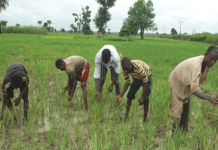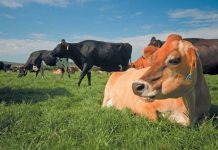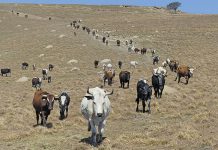 Choice of Land
Choice of Land
A well-drained land with a stocking density of 15 animals per hectare. Breeds
SHEEP
• West African Dwarf (Local)
• Balami
GOAT
• West African Dwarf (Local)
• Red Sokoto (Maradi)
To start a herd, get male animals of above a year of age with wide deep chest, well-sprung ribs, and strong hindquarters. A buck can serve 20 does. A doe should have at least two pairs of teats.
Housing
• Build a house with either bamboo or mud with thatched roof. Space required is about 2 sq. m. per animal. House should be open on one side. Walls up to 1.2 m on the other three, with a gap of 0.5 m to 0.8 m between the walls and roof, to provide sufficient ventilation without drought.
• Housing could be on raised floor made of bamboo with the thatched roof covering mid-way into the pens on both sides. Space could be as above.
• Fencing: Leguminous fodder trees like Gliricidia sepium and Leucaena leucocephala should be planted around the edges of the paddock to form a solid fencing and browse plants for the animals. Slatted bamboo or barbed wires can be used to complete the fencing.
Management procedure
A quarantine period of 30 days should be observed in bringing freshly purchased animals into a flock. This gives ample time for observation and attack by any disease. Animals of about 15 months of age or 12 kg (about half weight of bag of livestock feed) should be purchased. They should be bought from the villages rather than the market. The incidence of pestes des petitis ruminants (PPR) or “Kata” a rinderpest-like viral disease is rampant whenever goats from different sources are gathered in the local markets for sale. Animals are dipped in gammatex or supona solution twice in two weekly intervals. From the first day and for a period of 4 days, the animals should be administered with triple sulphonamide, like theracazan. On the first day of arrival in the farm, they should be immunized with rinderpest hyper-immune serum followed by vaccination with tissue culture rinderpest vaccine (TCRV) on the 11th day. On the 3rd and 24th days of arrival, they should be treated with broad-spectrum anthelmintic e.g., thiabendazole. In the absence of veterinary drugs, newly purchased animals should be watched closely. If there are signs of disease, such animals should be temporarily culled. If the disease persists the animals should be disposed off.
Feeding
Feed adult animals with hay or crop residue free choice plus legume hay at 1-2 kg/animal/day. Maize, soyabean, cowpea, millet or sorghum straws obtained after harvesting can be collected, treated and given to the animals free choice. Dissolve about 0.5 of ash made from cocoa pod husk or 1kg ash from palm bunch into a bucket of water to make a lye solution. Soak as much of the straw as possible into the solution and leave it overnight. Feed it straight the next morning or dry for some few hours before feeding, to increase intake. Animals can then be allowed to graze or browse afterwards. For pregnant does, and freshly weaned animals, it may be necessary to feed some concentrate consisting of 40% wheat offals, 25% brewers’ dried grains, 25% palm kernel mean, and 10% cassava peels or cowpea husk, 1% vitamin and 1% salt or supplement with 200g DM of legume fodder per day in the last 2 months of pregnancy and up to weaning at 3 months post partum.
Alley farming
Leguminous fodder trees (as under fencing) could be planted in rows on arable land, with food crops planted between the rows. Trees often established by direct seeding may be sown about 2 weeks after food crops like maize, cassava, melon, yam etc. Spacing between trees should be about 25 cm (distance from head to the toe on a foot) with four rows of food crops or 4 strides between two rows of trees. Browsing or cutting could start 1 year after planting. Advantages include provision of high protein fodder for livestock and manure and mulch from the fodder maintain and improve soil fertility for food crops while the trees limit erosion on sloping land.
Diseases
It is better to start a livestock farm during the dry season, as many of the diseases prevalent among small ruminants are commonest during the wet season. In case of outbreak of PPR (Kata), the affected animals should be isolated. Mouth lesions should be treated with dilute solution of potassium permanganate. The animals should be dewormed to control diarrhoea and treated with a potent anti-bacterial agent for 3 days. Always consult your veterinarian.




